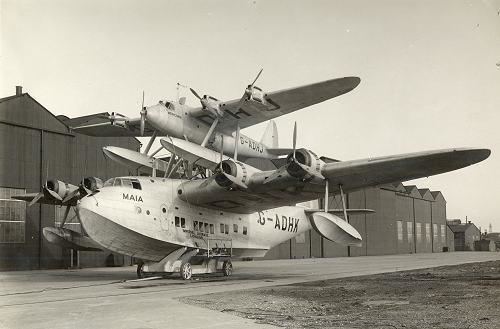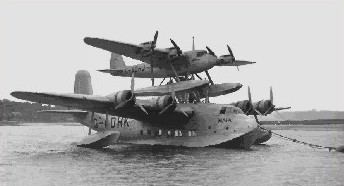Top speed 341 km/h Length 16 m Retired 11 May 1941 | Wingspan 22 m Introduced 14 July 1938 First flight July 27, 1937 | |
 | ||
The short mayo composite
The Short Mayo Composite was a piggy-back long-range seaplane/flying boat combination produced by Short Brothers to provide a reliable long-range air transport service to the United States and the far reaches of the British Empire and the Commonwealth.
Contents
- The short mayo composite
- Short mayo composite aircraft
- Development
- Design
- Operations
- Operators
- Specifications S20 Mercury
- Specifications S21 Maia
- In popular culture
- References

Short mayo composite aircraft
Development

Short Brothers had built the Empire flying boats which were capable of operating long range routes across the British Empire but could only attempt the trans-Atlantic route by replacing passenger and mail-carrying space with extra fuel.

It was known that aircraft could maintain flight with a greater load than is possible to take off with; Major Robert H. Mayo, Technical General Manager at Imperial Airways proposed mounting a small, long-range seaplane on top of a larger carrier aircraft, using the combined power of both to bring the smaller aircraft to operational height, at which time the two aircraft would separate, the carrier aircraft returning to base while the other flew on to its destination. The British Air Ministry issued Specification "13/33" to cover this project.
Design

The Short-Mayo composite project, co-designed by Mayo and Shorts chief designer Arthur Gouge, comprised the Short S.21 Maia, (G-ADHK) which was a variant of the Short "C-Class" Empire flying-boat fitted with a trestle or pylon on the top of the fuselage to support the Short S.20 Mercury(G-ADHJ).

Although generally similar to the Empire boat, Maia differed considerably in detail: the hull sides were flared and had "tumblehome" rather than being vertical as on the Empire to increase the planing surface (necessary for the higher takeoff weights); larger control surfaces; an increase in total wing area from 1,500 sq ft (140 m2) to 1,750 sq ft (163 m2); the engines were mounted further from the wing root to clear Mercury's floats and the rear fuselage was swept up to raise the tailplane relative to the wing. Like the Empire boats, Maia could be equipped to carry 18 passengers. Maia first flew (without Mercury) on 27 July 1937, piloted by Shorts' Chief Test Pilot, John Lankester Parker.
The upper component, Mercury, was a twin-float, four-engine seaplane crewed by a single pilot and a navigator, who sat in tandem in an enclosed cockpit. It could carry 1,000 lb (456 kg) of mail and 1200 Imperial gallons of fuel. Flight controls, except for elevator and rudder trim tabs, were locked in neutral until separation. Mercury's first flight, also piloted by Parker, was on 5 September 1937.
The mechanism that held the two aircraft together allowed for a small degree of movement. Lights indicated when the upper component was in fore-aft balance so trim could be adjusted prior to release. The pilots could then release their respective locks. At this point the two aircraft remained held together by a third lock which released automatically at 3,000 lb. The design was such that at separation Maia would tend to drop while Mercury would climb.
Operations
The first successful in-flight separation was carried out from the Shorts works at Borstal, near Rochester, Medway, on 6 February 1938, Maia piloted by Parker and Mercury by Harold Piper. Following further successful tests, the first transatlantic flight was made on 21 July 1938 from Foynes, on the west coast of Ireland, to Boucherville, near Montreal, Quebec, Canada, a flight of 2,930 miles (4,714.4 km). Maia, flown by Captain A.S. Wilcockson, took off from Southampton carrying Mercury piloted by Captain Don Bennett. As well as Mercury, the launch aircraft Maia was also carrying 10 passengers and luggage. Mercury separated from her carrier at 8 pm to continue what was to become the first commercial non-stop East-to-West transatlantic flight by a heavier-than-air machine. This initial journey took 20 hrs 21 min at an average ground speed of 144 mph (232 km/h).
The Maia-Mercury composite continued in use with Imperial Airways, including Mercury flying to Alexandria, Egypt, in December 1938. After modifications to extend Mercury's range, it established a record flight for a seaplane of 6,045 miles (9,726.4 km) from Dundee in Scotland to Alexander Bay, in South Africa between 6 and 8 October 1938.
Only one example of the Short-Mayo composite was built, the S.21 Maia with the registration G-ADHK and the S.20 Mercury G-ADHJ. The development of a more powerful and longer-range Empire boat (the Short S.26), the increase in allowable all-up weights with the standard "C-Class", the further development of in-flight refuelling and the outbreak of the Second World War combined to render the approach obsolete. Maia was destroyed in Poole Harbour by German bombers on 11 May 1941. Mercury was flown to Felixstowe for use by 320 (Netherlands) Squadron RAF a Dutch seaplane reconnaissance unit serving with the Royal Air Force at RAF Pembroke Dock. When this squadron was re-equipped with Lockheed Hudsons, Mercury was returned to Shorts at Rochester on 9 August 1941 and broken up so that its aluminium could be recycled for use in the war effort.
Operators
Specifications (S.20 Mercury)
Data from Barnes & James 1989 p.312
General characteristics
Performance
Specifications (S.21 Maia)
Data from Barnes & James 1989 p.312
General characteristics
Performance
